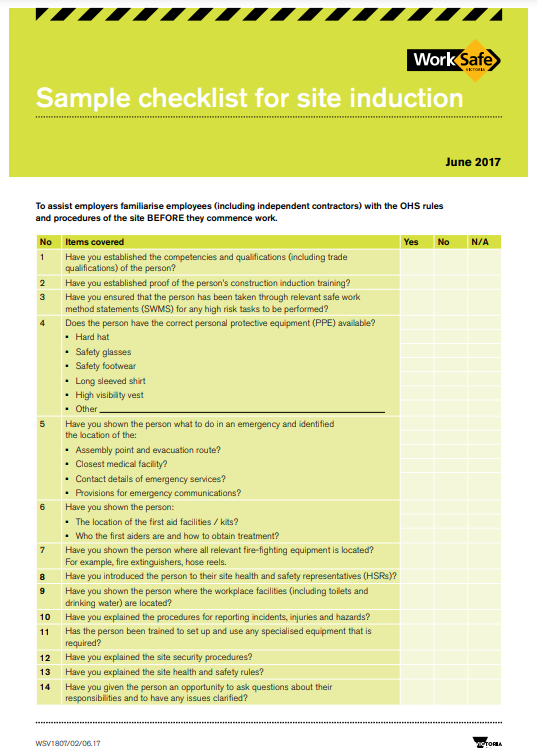In carrying out your work health and safety (WHS) duties, you will be called upon to assist management and/or the person conducting a business or undertaking (PCBU) with ensuring that the workplace has an appropriate organisational structures, policies and procedures framework to enable compliance with the applicable work health and safety laws.

Compliance in Work Health and Safety (WHS) refers to the adherence and fulfilment of legal and regulatory requirements related to workplace health and safety. It involves ensuring that organisations, employers, employees, and other duty holders meet their obligations under WHS legislation, regulations, and codes of practice.
Compliance in WHS
All Australian businesses are legally required to comply with WHS legislation. Compliance with WHS legislation involves several key components:
| Legal Obligations | Following the specific laws and regulations that apply to the industry and workplace to ensure a safe working environment. This includes national WHS laws, state or territory regulations, and relevant industry standards. |
| Implementation of Policies and Procedures | Developing and enforcing policies and procedures that outline safe work practices, hazard management protocols, emergency procedures, and reporting mechanisms. |
| Risk Assessment and Management | Identifying potential hazards in the workplace, assessing the associated risks, and implementing measures to control and mitigate these risks. |
| Training and Education | Providing adequate training and education to employees to ensure they understand their roles and responsibilities in maintaining workplace safety. |
| Monitoring and Review | Regularly monitoring and reviewing WHS practices, policies, and procedures to ensure they remain effective and compliant with changing legal requirements and industry standards. |
| Documentation and Record-Keeping | Maintaining accurate records of WHS activities, incidents, risk assessments, training sessions, and compliance checks as evidence of adherence to WHS laws. |
Compliance in WHS is crucial not only for legal reasons but also for fostering a safe and healthy work environment that protects the well-being of employees, contractors, visitors, and the broader community associated with the workplace.
Compliance Assessment Plans
Developing and implementing compliance assessment plans for Work Health and Safety (WHS) ensures that organisations adhere to relevant laws, regulations, and industry standards. These plans serve as a systematic approach to evaluating and improving the effectiveness of safety practices within the workplace. By regularly assessing compliance, organisations can identify areas of improvement, mitigate risks, and foster a culture of safety. This introduction will outline WHS compliance assessment plans' purpose, importance, and key components, setting the stage for a safer and more compliant work environment.
The primary purpose of WHS compliance assessment plans is to establish a structured framework for monitoring and evaluating an organisation’s adherence to WHS requirements. These plans help:
- Ensure that all WHS policies and procedures are effectively implemented and followed.
- Identify and rectify non-compliance issues before they lead to accidents or legal penalties.
- Promote continuous improvement in health and safety practices.
- Demonstrate a commitment to maintaining a safe and compliant workplace.
What to include in your Plan
| Objectives and Goals |
|
| Scope of Assessment |
|
| Criteria for Compliance |
|
| Risk Assessment |
|
Steps in Developing an Assessment Compliance Plan
Creating a robust Compliance Assessment Plan is crucial for maintaining Workplace Health and Safety (WHS) standards within an organisation. This process involves several key steps to ensure thorough evaluation, implementation, and continuous improvement of compliance practices.
The journey begins with an initial evaluation to establish a baseline understanding of current WHS compliance, using various tools such as checklists, surveys, and interviews. A detailed plan is developed, outlining the methodologies, tools, timelines, and responsibilities required for effective assessment.
Implementation involves executing the plan with regular audits and inspections and leveraging internal and external auditors to ensure a comprehensive evaluation. Corrective actions are developed, prioritised, and implemented upon identifying non-compliance issues to enhance WHS standards.
Lastly, continuous monitoring and regular reviews are essential to adapting and updating the plan, incorporating employee and stakeholder feedback to sustain a safety and compliance culture.
| Process | |
|---|---|
| Initial Evaluation |
|
| Developing the Plan |
|
| Implementation |
|
| Corrective Actions |
|
| Monitoring and Review |
|
Benefits of a Comprehensive Compliance Assessment Plan
- Enhanced Safety: Proactively identifying and mitigating risks reduces workplace accidents and injuries.
- Legal Compliance: Ensures adherence to WHS laws, preventing legal issues and fines.
- Employee Well-being: Demonstrates a commitment to employee health and safety, boosting morale and productivity.
- Reputation Management: Builds a positive reputation for the organisation as a safe and responsible employer.
- Financial Savings: Reduces costs associated with workplace injuries, legal penalties, and insurance premiums.
Developing and maintaining a robust compliance assessment plan is crucial for ensuring workplace safety and adhering to WHS regulations. By systematically evaluating and improving safety practices, organisations can protect their employees, avoid legal issues, and enhance their overall operational efficiency. Regular updates and continuous improvement are key to keeping the plan effective and relevant in the dynamic landscape of health and safety regulations.

Identifying non-compliance issues is critical to maintaining effective Work Health and Safety (WHS) compliance. This process detects areas where workplace practices do not meet established safety standards and regulatory requirements.
Some methods in which you can use to identify non-compliance in the workplace include:
Workplace Inspections
- Conduct regular and thorough inspections of the workplace.
- Use standardised checklists based on WHS regulations and best practices.
- Inspect all areas, including less obvious places like storage rooms and maintenance areas.
Safety Audits:
- Perform comprehensive safety audits periodically.
- Engage both internal and external auditors for objective assessments.
- Review documentation, procedures, and records related to health and safety.
Employee Reporting:
- Encourage employees to report safety concerns and non-compliance issues.
- Implement anonymous reporting systems to ensure employees feel safe to share information.
- Regularly review and act on employee reports.
Incident Investigations:
- Investigate all workplace incidents, including near misses.
- Analyse the root causes of incidents to identify underlying non-compliance issues.
- Document findings and corrective actions taken.
Risk Assessments:
- Conduct regular risk assessments to identify potential hazards.
- Assess the effectiveness of existing control measures.
- Update risk assessments when changes in the workplace occur, such as new equipment or processes.
Below are some examples of common non-compliance areas you may find within the workplace.
Common Areas of Non-Compliance
1. Training and Competency:
- Inadequate training programs for employees on WHS procedures.
- Lack of documentation proving employees' competency in safety practices.
2. Hazard Communication:
- Poor labelling and signage for hazardous materials.
- Inadequate communication of safety protocols and emergency procedures.
3. Personal Protective Equipment (PPE):

- Insufficient supply of necessary PPE.
- Employees not using PPE correctly or consistently.
4. Workplace Conditions:
- Poor housekeeping leading to slip, trip, and fall hazards.
- Inadequate lighting, ventilation, and ergonomic setup.
5. Maintenance and Equipment:
- Failure to regularly maintain and inspect equipment.
- Use of outdated or unsafe machinery.
Steps to Address Non-Compliance Issues
Addressing non-compliance issues in Work Health and Safety (WHS) is essential for maintaining a safe workplace and ensuring adherence to legal and regulatory standards. When non-compliance is identified, it is critical to take prompt and effective action to fix the situation, reduce risks, and prevent future occurrences.
Non-compliance with WHS standards can have serious consequences, including workplace accidents, injuries, legal penalties, and damage to an organisations reputation. Therefore, it is very important to address these issues promptly and effectively.
Ways in which you ensure WHS compliance issues are dealt with accordingly include the following strategies:
Documentation and Reporting
Record all identified non-compliance issues comprehensively.
Create detailed reports outlining the nature of each issue, its potential impact, and required corrective actions.
Root Cause Analysis
Conduct a thorough root cause analysis for each non-compliance issue.
Identify underlying problems contributing to non-compliance, such as process gaps or lack of training.
Corrective Actions
Develop and implement action plans to address each identified issue.
Assign responsibilities and set deadlines for corrective measures.
Monitor the effectiveness of corrective actions and make adjustments as needed.
Employee Training and Engagement
Provide additional training to employees on identified areas of non-compliance.
Involve employees in developing and implementing solutions to foster ownership and
accountability
Review and Continuous Improvement
Regularly review non-compliance data and trends.
Use insights from past issues to improve future compliance efforts.
Update policies, procedures, and training programs based on lessons learned.
Benefits of Identifying Non-Compliance Issues
This proactive way of identifying and managing non-compliance will help to reduce the chance of a workplace accident or injury, raising the level of safety for all workers. Compliance with WHS laws and regulations frees the organisation from legal penalties or fines.
These steps shall further emphasise the culture of safety and continuous improvement in the organisation, demonstrating care and safety standards for its people. In general, preventing accidental disruptions and safety violations enhances operational efficiency and overall productivity.
Identifying non-compliance issues is essential for maintaining a safe and compliant workplace. Through regular inspections, audits, employee engagement, and thorough investigations, organisations can uncover areas of non-compliance and take corrective actions.
By addressing these issues promptly and effectively, businesses can protect their employees, meet regulatory requirements, and promote a culture of safety and continuous improvement.
Responding to Non-Compliance in the Workplace
Non-compliant findings in Workplace Health and Safety (WHS) are critical indicators that an organisations safety measures are not meeting required standards. These findings can reveal significant gaps and vulnerabilities that threaten employee safety and organisational integrity. Common non-compliant findings often include inadequate safety training, improper equipment maintenance, insufficient risk assessments, and lack of emergency preparedness.
Identifying and addressing these issues promptly is vital for improving safety protocols, ensuring compliance with regulatory requirements, and protecting the health and well-being of all employees within the organisation.
Organising compliance assessment findings involves systematically categorising and prioritising the data collected during the assessment process. This ensures that the information is easily accessible and actionable.
Key steps include:
Classification
- Group findings by type, such as physical hazards, procedural issues, and training deficiencies.
- Categorise based on severity, ranging from minor infractions to critical violations.
Prioritisation
- Rank findings based on the level of risk they pose to health and safety.
- Focus on addressing high-risk issues first.
Documentation
- Use a standardised format for recording findings to maintain consistency.
- Include details such as the location, nature of the issue, and any immediate actions taken.
Tracking
- Implement a tracking system to monitor the status of each finding.
- Update the status regularly as corrective actions are implemented.
Writing a WHS Compliance Report

Writing a compliance report is essential for ensuring that an organisation adheres to established regulations and standards, particularly in areas like Workplace Health and Safety (WHS).
This report serves as a comprehensive document that outlines the findings from compliance assessments, identifies areas of non-compliance, and provides actionable recommendations for improvement.
It begins with a clear overview of the assessment's objectives and scope, followed by detailed analysis and evidence of compliance levels. By systematically documenting the compliance status and any corrective actions taken or needed, the report helps maintain regulatory adherence and supports continuous improvement in safety and operational procedures. This structured approach fosters transparency, accountability, and a proactive culture of compliance within the organisation.
Preparing compliance assessment reports involves compiling the organised findings into a comprehensive document, and communicating the assessment results clearly and effectively.
Key elements include:
| Executive Summary: |
|
| Detailed Findings: |
|
| Analysis: |
|
| Recommendations: |
|
Developing Recommendations for Compliance Improvement
Developing actionable recommendations involves creating specific, practical strategies to address identified non-compliance issues and enhance workplace safety. Recommendations should be clear and concise, detailing the steps required to rectify each issue. Considering its operations, resources, and constraints, they should be tailored to the organisation's unique context. Effective recommendations often include policies, procedures, training programs, and equipment changes. By focusing on actionable steps, organisations can ensure that recommendations are not only feasible but also directly contribute to improved compliance and safety outcomes
Developing recommendations for compliance improvement involves creating actionable strategies to address identified non-compliance issues and enhance overall safety.
Key steps include:
Documenting Recommendations
Documenting recommendations involves creating a detailed and organised record of all proposed actions to address non-compliance issues. This documentation should include the rationale behind each recommendation, the steps to be taken, responsible parties, and timelines for implementation.
Clear and thorough documentation ensures that everyone involved understands their roles and responsibilities, and it provides a reference for tracking progress and evaluating the effectiveness of the implemented measures. Comprehensive documentation also supports transparency and accountability in the compliance improvement process.
Communicating Assessment Outcomes to Relevant Parties
Communicating assessment outcomes to relevant parties involves effectively sharing the results of compliance assessments with stakeholders to ensure transparency and accountability. The first step in this process is targeted communication. It is crucial to identify key stakeholders, including management, employees, and regulatory bodies, and tailor the communication to meet each group's specific needs and interests. This ensures that the information is relevant and accessible to everyone involved.
Clear reporting is the next essential step. The findings and recommendations should be presented using clear, concise language and visuals to ensure understanding. Highlighting key issues and urgent actions will help prioritise the necessary steps for compliance improvement.
Incorporating feedback mechanisms is vital for continuous improvement. Providing opportunities for stakeholders to ask questions and offer feedback fosters a collaborative environment. This feedback should then be integrated into the compliance improvement process, ensuring that all perspectives are considered and that the organisation can adapt and improve its compliance practices effectively.
Communicating assessment outcomes to relevant parties
- Identify key stakeholders, including management, employees, and regulatory bodies.
- Tailor communication to the needs and interests of each group.
- Use clear, concise language and visuals to present findings and recommendations.
- Highlight key issues and urgent actions required.group.
- Provide opportunities for stakeholders to ask questions and provide feedback.
- Incorporate feedback into the compliance improvement process.
Following Up on Reported Compliance Issues
Following up on reported compliance issues is important in ensuring WHS standards are maintained and improved within any organisation. This would ensure that reporting of non-compliance is effectively addressed promptly, thereby averting potential risks and promoting continuous improvement.
Critical activities associated with this phase include monitoring the full implementation of the corrective actions, reviewing the compliance status, and maintaining open communication with the stakeholders. Following up on reported compliance issues involves monitoring the implementation of corrective actions and verifying their effectiveness.
Key steps include:
- Tracking System: Use a tracking system to monitor the status of each reported issue and corrective action.
- Verification: Conduct follow-up inspections and audits to ensure corrective actions have been implemented effectively and document the results of follow-up activities.
- Continuous Improvement: Use follow-up findings to identify areas for further improvement. Update compliance plans and procedures based on lessons learned from follow-up activities.
Implementing Recommendations
Implementing recommendations involves implementing the proposed actions to address non-compliance issues and improve workplace safety. This process requires careful planning, resource allocation, and effective project management.
Key steps include assigning responsibilities, setting timelines, and monitoring progress to ensure that recommendations are executed as planned. Communication and training are also vital to ensure that all stakeholders understand the changes and their roles in the implementation process. By systematically implementing recommendations, organisations can enhance compliance with WHS standards, reduce risks, and create a safer working environment.

PCBUs must ensure all workers have the training to safely carry out their work tasks in compliance with workplace procedures. Every workplace should undertake a minimum of safety induction training for two (2) reasons
- taking on new employees
- refresh worker knowledge and training, especially when things change in the legislation or organisation.
Some workplaces need more training than others, and accredited training is required for certain tasks, such as entering and working in confined spaces, acting as an HSR, being a first aider, working at heights or working with asbestos and other hazardous materials.
Employee Onboarding
Employee onboarding is a comprehensive process designed to integrate new hires into our organisation and provide existing employees with refresher training. For new employees, onboarding introduces them to our company's values, culture, and operational procedures, ensuring they have the necessary knowledge and skills to begin their roles confidently.
For current employees, it serves as a refresher to reinforce critical practices and update them on any new policies or procedural changes. This process is essential for fostering a safe, productive, and cohesive work environment for all team members.
To find out more about the process of onboarding employees, click here. You will be able to explore the steps on how businesses onboard new and existing staff as well as the checklists they use to support them.
Below is a sample Checklist used for Site Induction from Work Safe Victoria

Work Safe Victoria (2018). WorkSafe Victoria - Home - WorkSafe. [online] Vic.gov.au. Available at: https://www.worksafe.vic.gov.au/.
Training Needs Analysis
A training needs analysis reviews the PCBU’s legal responsibilities for providing training, compares the current training levels of the workforce, and makes recommendations for further training, whether in-house training or accredited training provided by technical and further education (TAFE) or registered training organisations (RTOs).
Further training needs analysis may also be required after an incident, and investigation finds that training was lacking.
Tip
Records of training requirements and individual workers’ training status must be maintained, updated and kept with the individuals' human resources (HR) records, and completion or enrolment in training may form a part of workers’ annual performance reviews. Training records may also form a legal defence if an employer or PCBU is prosecuted for WHS non-compliance.
Training is a fundamental component of an effective Work Health and Safety (WHS) system. It equips employees with the knowledge and skills they need to perform their tasks safely and comply with WHS regulations.
Importance of WHS Training
Work health and safety training is essential for several reasons:
- Legal Compliance: Ensures the organisation meets its legal obligations under WHS laws and regulations.
- Risk Reduction: Helps identify potential hazards and implement measures to control or eliminate them.
- Safety Culture: Promotes a culture of safety within the organisation, encouraging proactive participation in WHS activities.
- Emergency Preparedness: Prepares employees to respond effectively to emergencies, reducing the impact of incidents.
- Continuous Improvement: Supports the ongoing improvement of WHS practices and procedures through regular training and upskilling.
Training employees in Work Health and Safety (WHS) is a multi-step process that requires careful planning, execution, and continuous improvement. Here's a detailed overview of the process to ensure successful training:
1. Identifying WHS Training Needs
Identifying Work Health and Safety (WHS) training needs is the first step in ensuring that employees have the knowledge and skills necessary to maintain a safe workplace. This involves analysing job roles, workplace hazards, and incident records to determine the specific safety competencies required. Key sources of information include risk assessments, safety audits, and feedback from employees and supervisors. By understanding the gaps in current safety knowledge and practices, organisations can tailor their training programs to address the most critical areas and prevent workplace incidents.
2. Conducting Training Needs Assessments
Conducting training needs assessments is a systematic approach to identifying the specific WHS training requirements within an organisation. This process involves gathering data through surveys, interviews, and observations to evaluate employees' current skills and knowledge against the desired safety standards. The assessment should consider various factors such as changes in legislation, the introduction of new equipment or processes, and the frequency of workplace incidents. By accurately identifying training needs, organisations can develop targeted training programs that address specific gaps and enhance overall safety performance.
3. Developing WHS Training Plans
Developing WHS training plans involves creating a structured approach to deliver the identified training needs effectively. A comprehensive training plan outlines the objectives, content, methods, and schedule for each training program. It should include both initial and ongoing training to ensure continuous improvement in safety practices. The plan should also allocate resources such as trainers, materials, and facilities, and establish criteria for evaluating the success of the training. By having a well-developed training plan, organisations can ensure that their training efforts are organised, consistent, and aligned with their safety goals.
4. Selecting Appropriate Training Methods
Selecting appropriate training methods is crucial for the effectiveness of WHS training programs. Different methods suit different types of content and learning styles. Common training methods include classroom-based instruction, online courses, hands-on workshops, and simulations. The method choice should consider the material's nature, the trainees' characteristics, and the available resources. For example, hands-on training is particularly effective for tasks requiring physical skills, while online courses may be suitable for theoretical knowledge. Organisations can enhance learner engagement and knowledge retention by choosing the right training methods.
5. Delivering WHS Training
Delivering WHS training effectively requires skilled trainers and a supportive learning environment. Trainers should have subject matter expertise and the ability to engage and motivate learners. Training sessions should be interactive, incorporating real-life scenarios and practical exercises to reinforce learning. It is also important to accommodate different learning styles and provide opportunities for feedback and questions. Ensuring that training is accessible and relevant to all employees helps to foster a culture of safety and encourages the application of learned skills in the workplace.
6. Ensuring Training Meets Legislative Requirements
Ensuring that WHS training meets legislative requirements is essential for legal compliance and the protection of employees. Training programs should be designed and delivered by relevant WHS laws, regulations, and industry standards. This involves staying updated with changes in legislation and ensuring that training content covers all required topics. Organisations may also need certification or approval from regulatory bodies to validate their training programs. By meeting legislative requirements, organisations can avoid legal penalties and demonstrate their commitment to maintaining a safe and compliant workplace.
7. Monitoring and Evaluating Training Effectiveness
Monitoring and evaluating the effectiveness of WHS training programs is crucial for continuous improvement. This involves assessing whether training objectives are met and if employees apply their new knowledge and skills in the workplace. Evaluation methods include quizzes, feedback surveys, observations, and incident rate analysis. By regularly reviewing training outcomes, organisations can identify areas for improvement, adjust training content and methods, and ensure that training contributes to a safer work environment.
8. Documenting Training Provided
Documenting the training provided is an important aspect of WHS management. Accurate records of all training activities should be maintained, including attendance, content covered, and assessment results. Documentation serves multiple purposes: it provides evidence of compliance with regulatory requirements, supports performance evaluations, and helps identify future training needs. Digital record-keeping systems can streamline the documentation process and make retrieving and analysing training data easier.
Updating Training Programs as Necessary
Updating training programs as necessary ensures that WHS training remains relevant and effective. This involves regularly reviewing and revising training content to reflect changes in legislation, industry standards, workplace practices, and emerging hazards. Feedback from trainees and trainers, as well as data from training evaluations and incident reports, can inform updates. By keeping training programs current, organisations can continuously improve their safety culture and ensure that employees are equipped to handle new and evolving risks.
Collaborating with Stakeholders on Training Initiatives
Collaborating with stakeholders on training initiatives enhances the relevance and effectiveness of WHS training programs. Stakeholders include employees, management, safety representatives, and external experts. Involving them in the planning, development, and delivery of training ensures that diverse perspectives are considered and that training addresses the actual needs of the workforce. Collaboration can also foster a sense of ownership and commitment to safety initiatives. By working together, stakeholders can create comprehensive and impactful training programs that support a culture of safety and continuous improvement.
Conducting training for a work team
Conducting training for a work team is an essential component of maintaining a safe, efficient, and compliant workplace. Effective training ensures that all team members are equipped with the necessary skills, knowledge, and understanding to perform their tasks safely and competently. This process is particularly important when introducing new policies, procedures, or equipment, as it helps prevent accidents, enhances productivity, and fosters a culture of continuous improvement and safety. By investing in comprehensive and regular training sessions, organisations can ensure compliance with industry regulations, improve employee morale, and ultimately achieve better operational outcomes.
To see an example of how a WHS officer plans a training session for the work team, see the following scenario.
Case Study

As a WHS officer, Maria is responsible for conducting a training session for a team of warehouse workers on new safety protocols related to the use of forklifts. The company has recently updated its safety procedures to comply with the latest WHS regulations, and it is crucial that all team members understand and implement these changes effectively.
Training Event Outline:
Overview of Training Event
Objective: To ensure all warehouse workers understand and can implement the new forklift safety protocols in compliance with the latest WHS regulations.
Duration: 3 hours
Participants: All warehouse staff, including forklift operators and their supervisors (approximately 20 employees).
Resources Required:
Training room with seating and AV equipment (projector, screen, speakers)
Printed copies of the updated safety protocol manual
Forklift for practical demonstrations
Safety gear for practical sessions (helmets, vests, gloves)
Sign-in sheet for attendance tracking
Feedback forms for post-training evaluation
Training Agenda and Activities
Introduction and Welcome (15 minutes)
- Maria introduces herself and outlines the objectives of the training.
- Brief overview of the importance of the new compliance requirements.
Presentation on New Compliance Requirements (45 minutes)
- Detailed explanation of the updated WHS regulations and how they impact forklift operations.
- Discussion of key changes in the safety protocols.
- Use of slides and videos to illustrate points.
Q&A Session (15 minutes)
- Open floor for employees to ask questions about the new protocols and compliance requirements.
Break (15 minutes)
Hands-on Practical Demonstration (1 hour)
- Maria demonstrates the correct use of a forklift according to the new safety protocols.
- Step-by-step guide on conducting pre-operational safety checks.
- Demonstration of proper loading and unloading techniques.
- Safe maneuvering practices and emergency procedures.
Employee Practice Session (30 minutes)
- Employees take turns practicing the new protocols under Maria’s supervision.
- Immediate feedback and correction of techniques to ensure compliance.
Group Discussion and Scenario-Based Learning (30 minutes)
- Small groups discuss potential scenarios and how to apply the new safety protocols.
- Presentation of group findings and discussion on best practices.
Conclusion and Wrap-Up (15 minutes)
- Recap of key points covered in the training.
- Distribution of feedback forms to gather employee input on the training effectiveness.
- Open invitation for further questions and discussion.
Post-Training Evaluation:
Collection and review of feedback forms to assess the effectiveness of the training.
Follow-up with individual employees as needed to ensure full understanding and compliance with the new protocols.
By following this structured training outline, Maria ensures that all warehouse workers are well-equipped with the knowledge and skills to operate forklifts under the new WHS compliance requirements safely.
